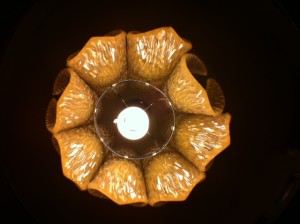The Syntax of Being (Part 1)
By Asher Crispe: June 11, 2012: Category Inspirations, Quilt of Translations
Lurianic Models and Beyond
—Is being language? Is language recognition of being?
Being holds language (which cannot encompass it) in
Check, but language likewise checks being (which cannot
Master it).
Then being owes its possibility to be to language, and
Language owes to the meditation of being its possibility to exist.
Edmond Jabès (1)
Ontotextual Ubiquity and Omnitextual Ontology
 When navigating the vast kabbalistic literature on the nature of language, one seldom sees a system. Linguistic considerations abound and hyper-reflective bursts of insight are not uncommon, but the denizens of this esoteric tradition resist the simultaneous laying down of all their cards in our full view. Not that we don’t have premonitions about the rest of the deck—of its contents and plausible configurations—we do. Yet, for all the inherent reluctance to divulge a fully formed theory language we encounter only an occasional cluster of high density ideas that are layered and interlaced into an elaborate conceptual scaffolding.
When navigating the vast kabbalistic literature on the nature of language, one seldom sees a system. Linguistic considerations abound and hyper-reflective bursts of insight are not uncommon, but the denizens of this esoteric tradition resist the simultaneous laying down of all their cards in our full view. Not that we don’t have premonitions about the rest of the deck—of its contents and plausible configurations—we do. Yet, for all the inherent reluctance to divulge a fully formed theory language we encounter only an occasional cluster of high density ideas that are layered and interlaced into an elaborate conceptual scaffolding.
One such well-spring emerges out of the traditions of Lurianic Kabbalah [Rabbi Yitzchak Luria 1534-1572]. Undeniably endeared with complexity, the Lurianic school (we will not engage the entangled questions of the membership and authorship of this ‘textual’ community in that many of its central works have acquired a life of their own) provides countless examples of pre-Boolean kabbalistic algebra coiling up into equations that at least look the part of a system. (2)
Captured in the condensed exposition of this school’s magnum opus Etz Chaim [first published 1782], we see an ‘overview’ of ontology that uses language and the textual unfolding of that language to support itself. Here, the Heideggerian assertion that: “Language is the house of Being” (3) rings loud and clear. Here, we partake of the Grammar of Being, or the Book of Being and the Being of the Book.
Chained together, language and Ontology, give rise to questions of meaning and interpretation. Thus, taken as a whole, the following text that we will investigate marks out the inner structures and arrangements that codify the mystery of information or disinformation (as the case may be) in the overall project of kabbalistic exegesis. From text to context, syntax and sign, we can discern a minimal network of relations from which to conjure our reflections ultimately forwarding them to future addresses—postmodern and beyond.
[Note to the reader: Do not be put off by this esoteric quotation. It will be explained in the course of these articles and can even be skipped with minimal loss…]
ונבאר עתה עניינם דע כי אין מציאות ציור קומת אדם בעולם שלא היה בו כללות ד’ בחי’ אשר כוללים כל האצילות וכל העולמות כולם ואלו הם ע”ב כזה יו”ד ה”י וי”ו ה”י. ס”ג יו”ד ה”י וא”ו ה”י. מ”ה יו”ד ה”א וא”ו ה”א. ב”ן יו”ד ה”ה ו”ו ה”ה. והנה אלו הד’ הויו”ת הנחלקים לד’ מלואין האלו הם ד’ בחי’ אלו הטעמים שם ע”ב. הנקודות שם ס”ג. התגין שם מ”ה. האותיות שם ב”ן. וכל אחד מאלו הד’ הויו”ת כלול מכולם ויש בכל הוי”ה מהם בחי’ טנת”א.
—עץ חיים, השער החמישי שער טנת”א פרק א
[Here follows an extremely loose translation….]
…for a complete picture encompassing the full expanse of human experience, one should know that it must contain four aspects of reality which are related to the emanated series of worlds [four in total] in their entirety. These ‘aspects’ are as follows [as they correlate to filling out the Tetragrammaton (the name Havayah) yud-hei-vav-hei]:
A”v [the name which equals 72] which is spelled yud-vav-dalet [10+6+4], hei-yud [5+10], vav-alef-vav [6+1+6], hei-yud [5+10].
S’ag [the name which equals 63] which is spelled yud-vav-dalet [10+6+4], hei-yud [5+10], vav-yud-vav [6+10+6], hei-yud [5+10].
M”ah [the name which equals 45] which is spelled yud-vav-dalet [10+6+4], hei-alef [5+1], vav-alef-vav [6+1+6], hei-alef [5+1].
B”an [the name which equals 52] which is spelled yud-vav-dalet [10+6+4], hei-hei [5+5], vav-vav [6+6], hei-hei [5+5].
These are four modes of being [four different expressions of Havayah (which itself means ‘being’ or ‘reality’)] that are divided according to their filling [or variant spelling out of the letters in the Divine name Havayah and they relate to the four levels of textual reading. Cantillation marks (ta’amim) relate to a”v [72], Vowels (nikudot) relate to s”ag, decorative Crowns (tagin or ornaments on the letters) relate to m”ah and the Letters (otiot) themselves relate to b”an.
Each of these four modes of being [four fillings of the Divine name Havayah] are interincluded within the next and each one contains all of the levels called tanta ([טנת”א] ta’amim, nikudot, tagin, otiot or Cantillation, Vowels, Crowns and Letters).
Tree of Life: Fifth Gate, Gate of Tanta, chapter 1
Taking inventory of the above passage, we find a four fold system of worlds that make up the aggregate of all states of the human constitution, patterns of experience and passageways of consciousness. Paralleled to the four letters of the Divine ineffable name that means “Being” we see that each individual letter is opened or filled out by an expansion of the Divine name that correlates all of the letters of the name as a whole within each its individual letters.
“Being” contains many expressions or modalities which are rendered as alternative spellings or unzipped encryptions. These modes of Being in turn resonate at distinct textual frequencies. The reality of the text which informs the textual (nature) of reality is also structured in a basic four level pattern. Expressed by the acronym tanta [טנת”א] representing (in sequence): Cantillation marks, Vowels, Crowns or Ornaments and Letters, we discover the multi-tiered unfolding of textuality.
Precisely related to the text of the Torah scroll, these four levels suggest a number of key features. For one, they naturally divide into two camps. The first camp of the ‘Cantillation marks’ couples with the ‘Vowels’ having the common denominator of being acoustic expressions that are formally absent from the written Torah scroll. By contrast, the written text exclusively comprises the second camp of the ‘Crowns’ and ‘Letters’ (conjoined as a single pictographic body) which are present in the scroll.
This division highlights the fundamental incompleteness of the text as text. Far from a sustainable independent written text whose readability rests on the autonomy of present signs, we are compelled to have immediate recourse to a tradition of orality. Reading must appeal to the outside. The literal is an unfinished body that can only be animated with the synergy of superadded Vocalization and Cantillation.
While one may be tempted to entertain the notion that a prose text is possible with only vocalization, we should be cautious to remember that the Cantillation marks signify more than the music of language transformed into its poetic overdrive. They deliver another more primal ingredient to the mix: grammar and syntax. Thus, the kabbalists acknowledge Cantillation marks as of ‘mode of Being’ or a ‘level of the text’ or ‘text constituting force’ in their own right. If “language is the house of Being,” then no house is complete without structural integrity conceived as part of its architectural design.
If we may compare the musicality of the text to an accentuation of the plain and straightforward manner of annunciation of letters and vowels, then we might justifiably conclude that music radicalizes the character of the words, nuances their meaning and carries them to new heights of signifying power. What is more, we may unpack a similar parallelism from the visual components of the text—the crown and letters.
 Every letter must be enclosed within the prescribed boundaries of its own form. As a sign, a letter may not over extend itself beyond its borders. It must remain self-similar. It cannot signify more than it signifies. Nonetheless, the popular phenomenon of “reading in between the lines,” of language possessing frequent moments of overstepping and overflow, of rupture and excess, breaks onto the scene by way of ornamental flourishes or crowns that radicalize the visual components of the text in a way similar to that of the Cantillation’s electrifying and emboldening the prosaic vocalization.
Every letter must be enclosed within the prescribed boundaries of its own form. As a sign, a letter may not over extend itself beyond its borders. It must remain self-similar. It cannot signify more than it signifies. Nonetheless, the popular phenomenon of “reading in between the lines,” of language possessing frequent moments of overstepping and overflow, of rupture and excess, breaks onto the scene by way of ornamental flourishes or crowns that radicalize the visual components of the text in a way similar to that of the Cantillation’s electrifying and emboldening the prosaic vocalization.
As diacritics, the Crowns, Vowels and Cantillation serve as the energy fields that animate the dark matter of the letters. Caught in the envelope of extra-textual influences, the letters themselves are objectionable in their suitability to be a signifying unit in and of themselves. Only the confluence of forces demonstrates their adequacy retroactively as the raw building materials of the house of Being known as language.
This house is built of and for a family of four. Every one is called Havayot “הויות” [modes of being] and each contains all of the others holographically. All of the modes of being contain these textual layers: each mode of being (represented by a filling or spelling out of the Divine name) contained a corresponding aspect of the (four textual levels) tanta [“…ויש בכל הוי’ה מהם בחי’ טנת”א”].
As an interlocking mechanism, they are suggestively like a Great Chain of Textual Being. Furthermore, as a recursive function, the four within four, within four…reverberates into the cosmos as the meta-text cut through with the grammar of creation. (4) Consequentially, as we stated before, this Lurianic fragment begins by offering the connection of Being in its various modes to the ‘texture’ of language as the rightful constitution of the human condition. It is not a small irony then, that the sentence that directly follows Heidegger’s famous and frequently quoted remark that: “Language is the house of Being” is “In its home man dwells.” (5) The congruence between the Heideggerian assertion and the Lurianic one is striking.
Others have duly noted the commonality in this and other passages in kabbalistic literature with more contemporary reformulations of infinite textuality. At the forefront of this most progressive avenue of analysis, we find the scholarship of Elliot Wolfson, whose substantial investment of resources has exposed connections both historical and beyond in the mix of postmodern thinkers who have taken up similar positions (informed or not) to those of Lurianic kabbalists.
Of the more salient descriptions that capture our attention and could have easily emerged directly out of a Lurianic text, is Derrida’s notion of unlimited textuality—the now famous mantra that “there is nothing outside the text.” Wolfson follows this thread through a number of comparisons in Kabbalah, digging at the underlining meaning of Derrida’s contention. Wolfson writes:
There is nothing that is not inscribed within the book and therefore open to interpretation, not even God’s being. One is reminded of the provocative observation of Jacques Derrida: il n’y pas de hors-texte, ‘there is nothing outside of the text’. All transcendence is reduced to textuality. (6)
Wolfson also cites an alternative reading from Kevin Hart for whom “accordingly, when Derrida claims that there is nothing outside of the text, he is making a remark concerning constitution, not concerning what is. In other words, he does not say that everything is only a text but that everything is also a text” (author’s emphasis). (7)
Following this interpretation, the ‘everything’ that is also a text would undoubtedly find compatibility with the Lurianic suggestion of Being structured as the text in the Book of Books—diacritics included. Canvassing this idea on a larger scale and underscoring the significance of the link to Heidegger, Wolfson maintains that:
Basic to classical Jewish belief is the view that the fabric of the world and human existence is textual. Not only is language the house of being, the clearing in which Being manifests itself by pulling away from its concealedness, as Heidegger would put it, but language is the very being that is unveiled. (8)
Again following suit with Heidegger, Wolfson picks up on the implications for our understanding of human consciousness, entertaining the logical necessity of ontology and language being given over to the government of grammar:
The hermeneutical circle in which we seem to be inextricably caught—or, in the vernacular of the day, the invariable hard-wiring of the human brain—is such that being is thought primarily from the perspective of language, and hence ontological categories are inseparable from grammatical assumptions. In Husserl’s formulation, the objects that ‘pure logic’ seeks to examine are ‘given to it in grammatical clothing.’ (9)
 Unable to shed its ‘grammatical clothing,’ our everyday experience unavoidably embraces the Being-language continuum such that the reminder that this Divine name under discussion has been rendered as “Being” only fuels the imagination especially when recast in the admirable locution on George Steiner (for whom Kabbalah and Heidegger can be counted among his acquaintances): “…any coherent understanding of what language is and how it performs, that any coherent account of the capacity of human speech to communicate meaning and feeling is, in the final analysis, underwritten by the assumption of God’s presence.” (10)
Unable to shed its ‘grammatical clothing,’ our everyday experience unavoidably embraces the Being-language continuum such that the reminder that this Divine name under discussion has been rendered as “Being” only fuels the imagination especially when recast in the admirable locution on George Steiner (for whom Kabbalah and Heidegger can be counted among his acquaintances): “…any coherent understanding of what language is and how it performs, that any coherent account of the capacity of human speech to communicate meaning and feeling is, in the final analysis, underwritten by the assumption of God’s presence.” (10)
Here Steiner responds to Nietzsche who in turn might as well be responding to our Lurianic text when he decrees that “I am afraid we are not rid of God because we still have faith in grammar.” (11) Grammar/Language/Logic/Ontology: this strange cabal is riddled with complexities, but only becomes a Nietzschean “idol” if they feign completeness. They must serve to unravel claims of totality rather than accomplish it. Thus we are left with an open book and an incomplete text.
1 The Book of Shares, p.70.
2 This is the contention of Elliot Wolfson for whom the Lurianic system is ultimately an ‘anti-system’ system in that its unwieldy complexity amounts to anything but being user friendly. This may be an example of complexity floating on chaos, meaning on meaninglessness, etc..
3 Martin Heidegger, “Letter on Humanism” in Basic Writings, p.217.
4 I am indebted to George Steiner’s Grammar of Creation for this phraseology.
5 “Letter on Humanism”, p.217.
6 “From Sealed Book to Open Text” in Interpreting Judaism in a Postmodern Age, p.146.
7 “From Sealed Book to Open Text” footnote 5 pp.167-168.
8 Ibid. p.146.
9 See Wolfson’s Language, Eros, Being pp.10-11. Here he evokes the authority of Husserl whose reference to ‘grammatical clothing’ appears in his Logical Investigations Vol.I p.250.
10 George Steiner, Real Presences, p.3.
11 From Twilight of the Idols, aph.5 (1889).
http://www.interinclusion.org/inspirations/the-syntax-of-being-part-2/























;)
;)
;)
;)
;)
;)
;)
;)
;)
;)
